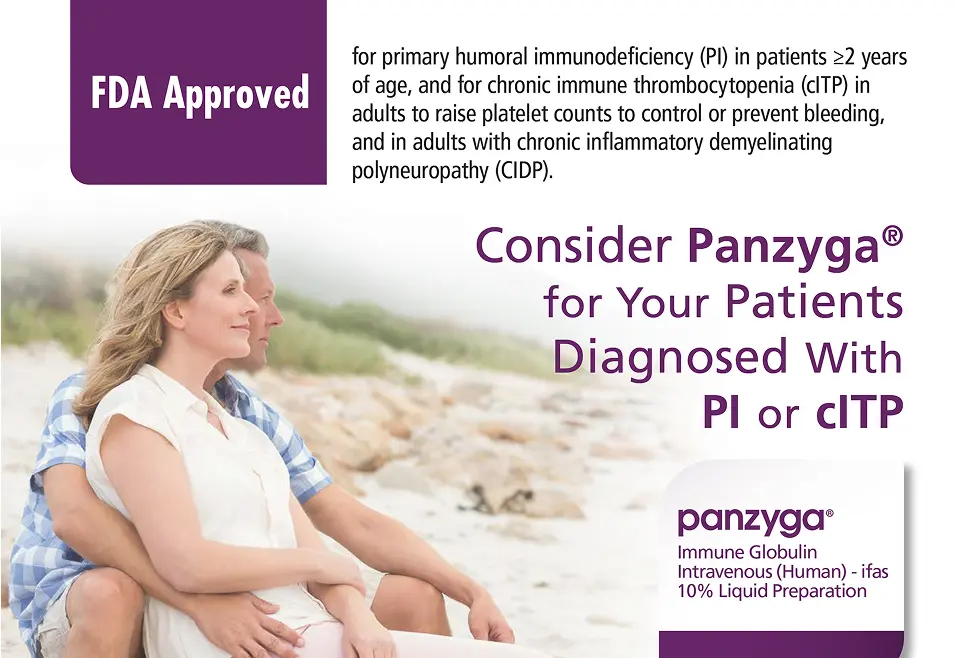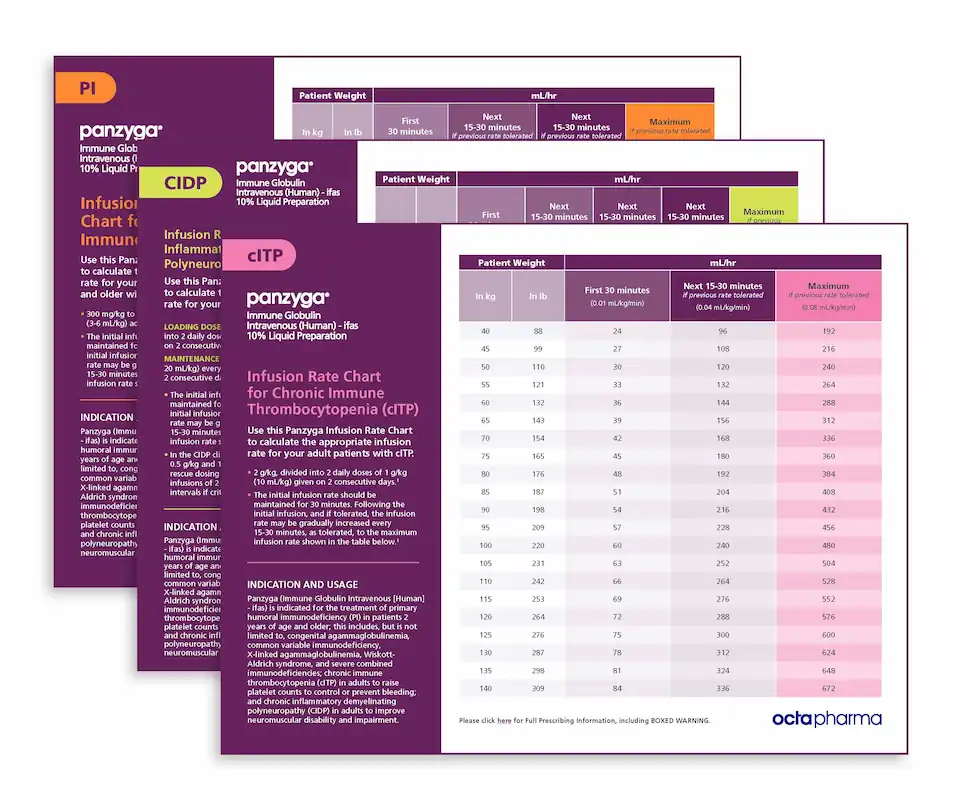
Panzyga offers Co-Pay Assistance
Helping eligible patients with financial
support through co-pay programs and other
reimbursement-related services.
Medical Benefits Billing
If the patient’s primary payer drug claim is billed under medical benefits, all requests for co-pay assistance must be billed through the medical benefits billing portal at:
panzyga.octapharma.medmonk.com
After completing a one-time Provider Registration and logging in, please follow these simple steps to get your patients copay assistance:
Provider Registration
If it is your first time, you will receive a confirmation email. Click the link to confirm your account before logging in. Check your SPAM folder if you don’t see it.
Submit Request
You can submit the request before or after the primary insurer pays (within 180 days of dispense date):
- Before Primary Payment: Submit with an estimated patient responsibility. The claim will be paid based on the uploaded Explanation of Benefits (EOB) and patient responsibility (for the drug only).
- After Primary Payment: Submit with the EOB and a CMS-1500 claim form, including the Octapharma NDC.
Patient Consent
Confirm patient written consent for co-pay assistance with the first claim. It must be renewed annually.
Approval and Payment
Once all documentation is received, the Octapharma Support Center will approve the EOB, and payment will be issued in 2-3 weeks. Missing or incorrect documentation will prompt an email notification.
Pharmacy Benefits Billing
If you’re billing the patient’s primary insurance through the pharmacy benefit, simply bill Medmonk as a secondary payer using the following claim processing information.
Program & Patient Eligibility Guidelines & Restrictions
- All patients must have commercial (private) insurance to qualify
- Patients whose insurance policy prohibits co-pay assistance are not eligible
- Those with Medicare, Medicaid, Medigap, VA, DOD, Tricare, or other federal or state government insurance are not eligible
- Patients must currently be using panzyga or have a prescription to begin therapy
- Eligible patients and/or their HCPs must complete an enrollment application — If co-pay claim is processed under pharmacy benefits, patients must sign a consent
- Patients can receive up to $12,500 on out-of-pocket costs per calendar year or the cost of patient’s co-pay in a 12-month period (whichever is less) for claims received by the program
- Providers will have an option to receive reimbursement via EFT, following sign up to the provider portal
Terms and conditions apply
INDICATIONS & IMPORTANT SAFETY INFORMATION FOR PANZYGA® IMMUNE GLOBULIN INTRAVENOUS (HUMAN) – IFAS 10% LIQUID PREPARATION
BOXED WARNING: THROMBOSIS, RENAL DYSFUNCTION, AND ACUTE RENAL FAILURE
Please click here for Full Prescribing Information, including BOXED WARNING.
- Thrombosis may occur with immune globulin intravenous (IVIg) products, including Panzyga. Risk factors may include: advanced age, prolonged immobilization, hypercoagulable conditions, history of venous or arterial thrombosis, use of estrogens, indwelling central vascular catheters, hyperviscosity, and cardiovascular risk factors. Thrombosis may occur in the absence of known risk factors.
- Renal dysfunction, acute renal failure, osmotic nephrosis, and death may occur in predisposed patients who receive IVIg products, including Panzyga. Patients predisposed to renal dysfunction include those with a degree of pre-existing renal insufficiency, diabetes mellitus, age greater than 65, volume depletion, sepsis, paraproteinemia, or patients receiving known nephrotoxic drugs. Renal dysfunction and acute renal failure occur more commonly in patients receiving IVIg products containing sucrose. Panzyga does not contain sucrose.
- For patients at risk of thrombosis, renal dysfunction, or acute renal failure, administer Panzyga at the minimum dose and infusion rate practicable. Ensure adequate hydration in patients before administration. Monitor for signs and symptoms of thrombosis and assess blood viscosity in patients at risk for hyperviscosity.
See Full Prescribing Information, Warnings and Precautions (5.2, 5.4)
Indications and Usage
Panzyga (Immune Globulin Intravenous [Human] – ifas) is indicated for the treatment of primary humoral immunodeficiency (PI) in patients 2 years of age and older; this includes, but is not limited to, congenital agammaglobulinemia, common variable immunodeficiency, X-linked agammaglobulinemia, Wiskott-Aldrich syndrome, and severe combined immunodeficiencies; chronic immune thrombocytopenia (cITP) in adults to raise platelet counts to control or prevent bleeding; and chronic inflammatory demyelinating polyneuropathy (CIDP) in adults to improve neuromuscular disability and impairment.
Contraindications
Panzyga is contraindicated in patients who have a history of severe systemic hypersensitivity reactions, such as anaphylaxis, to human immunoglobulin and in IgA-deficient patients with antibodies against IgA and history of hypersensitivity.
Warnings and Precautions
- Monitor renal function, including blood urea nitrogen and serum creatinine, and urine output in patients at risk of developing acute renal failure.
- Hyperproteinemia, increased serum osmolarity, and hyponatremia may occur in patients receiving Panzyga.
- Aseptic meningitis syndrome may occur in patients receiving Panzyga, especially with high doses or rapid infusion.
- Hemolysis that is either intravascular or due to enhanced red blood cell sequestration can develop subsequent to Panzyga treatments. Risk factors for hemolysis include high doses and non-O-blood group. Closely monitor patients for hemolysis and hemolytic anemia.
- Monitor patients for pulmonary adverse reactions (transfusion-related acute lung injury [TRALI]).
- Monitor blood pressure prior to, during, and following Panzyga infusion.
- Carefully consider the relative risks and benefits before prescribing the high dose regimen (for cITP) in patients at increased risk of volume overload.
- Panzyga is made from human plasma and may contain infectious agents, e.g. viruses and theoretically, the Creutzfeldt-Jakob disease agent.
Adverse Reactions
- PI – The most common adverse reactions reported in greater than 5% of subjects were: headache, nausea, fever, fatigue, and abdominal pain.
- cITP in adults – The most common adverse reactions reported in greater than 5% of subjects were: headache, fever, nausea, vomiting, dizziness, and anemia.
- CIDP in adults – The most common adverse reactions reported in greater than 5% of subjects were: headache, fever, dermatitis, and blood pressure increase.
The risk information provided here is not comprehensive; See full Prescribing Information and Boxed Warning for Panzyga.
To report suspected adverse reactions, contact Octapharma USA, Inc. at 1-866-766-4860 or the FDA at 1-800-FDA-1088 or www.fda.gov/medwatch.
INDICATIONS & IMPORTANT SAFETY INFORMATION FOR PANZYGA® IMMUNE GLOBULIN INTRAVENOUS (HUMAN) – IFAS 10% LIQUID PREPARATION
BOXED WARNING: THROMBOSIS, RENAL DYSFUNCTION, AND ACUTE RENAL FAILURE
Please click here for Full Prescribing Information, including BOXED WARNING.
- Thrombosis may occur with immune globulin intravenous (IVIg) products, including Panzyga. Risk factors may include: advanced age, prolonged immobilization, hypercoagulable conditions, history of venous or arterial thrombosis, use of estrogens, indwelling central vascular catheters, hyperviscosity, and cardiovascular risk factors. Thrombosis may occur in the absence of known risk factors.
- Renal dysfunction, acute renal failure, osmotic nephrosis, and death may occur in predisposed patients who receive IVIg products, including Panzyga. Patients predisposed to renal dysfunction include those with a degree of pre-existing renal insufficiency, diabetes mellitus, age greater than 65, volume depletion, sepsis, paraproteinemia, or patients receiving known nephrotoxic drugs. Renal dysfunction and acute renal failure occur more commonly in patients receiving IVIg products containing sucrose. Panzyga does not contain sucrose.
- For patients at risk of thrombosis, renal dysfunction, or acute renal failure, administer Panzyga at the minimum dose and infusion rate practicable. Ensure adequate hydration in patients before administration. Monitor for signs and symptoms of thrombosis and assess blood viscosity in patients at risk for hyperviscosity.
See Full Prescribing Information, Warnings and Precautions (5.2, 5.4)
Indications and Usage
Panzyga (Immune Globulin Intravenous [Human] – ifas) is indicated for the treatment of primary humoral immunodeficiency (PI) in patients 2 years of age and older; this includes, but is not limited to, congenital agammaglobulinemia, common variable immunodeficiency, X-linked agammaglobulinemia, Wiskott-Aldrich syndrome, and severe combined immunodeficiencies; chronic immune thrombocytopenia (cITP) in adults to raise platelet counts to control or prevent bleeding; and chronic inflammatory demyelinating polyneuropathy (CIDP) in adults to improve neuromuscular disability and impairment.
Contraindications
Panzyga is contraindicated in patients who have a history of severe systemic hypersensitivity reactions, such as anaphylaxis, to human immunoglobulin and in IgA-deficient patients with antibodies against IgA and history of hypersensitivity.
Warnings and Precautions
- Monitor renal function, including blood urea nitrogen and serum creatinine, and urine output in patients at risk of developing acute renal failure.
- Hyperproteinemia, increased serum osmolarity, and hyponatremia may occur in patients receiving Panzyga.
- Aseptic meningitis syndrome may occur in patients receiving Panzyga, especially with high doses or rapid infusion.
- Hemolysis that is either intravascular or due to enhanced red blood cell sequestration can develop subsequent to Panzyga treatments. Risk factors for hemolysis include high doses and non-O-blood group. Closely monitor patients for hemolysis and hemolytic anemia.
- Monitor patients for pulmonary adverse reactions (transfusion-related acute lung injury [TRALI]).
- Monitor blood pressure prior to, during, and following Panzyga infusion.
- Carefully consider the relative risks and benefits before prescribing the high dose regimen (for cITP) in patients at increased risk of volume overload.
- Panzyga is made from human plasma and may contain infectious agents, e.g. viruses and theoretically, the Creutzfeldt-Jakob disease agent.
Adverse Reactions
- PI – The most common adverse reactions reported in greater than 5% of subjects were: headache, nausea, fever, fatigue, and abdominal pain.
- cITP in adults – The most common adverse reactions reported in greater than 5% of subjects were: headache, fever, nausea, vomiting, dizziness, and anemia.
- CIDP in adults – The most common adverse reactions reported in greater than 5% of subjects were: headache, fever, dermatitis, and blood pressure increase.
The risk information provided here is not comprehensive; See full Prescribing Information and Boxed Warning for Panzyga.
To report suspected adverse reactions, contact Octapharma USA, Inc. at 1-866-766-4860 or the FDA at 1-800-FDA-1088 or www.fda.gov/medwatch.


